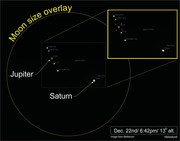I got home from an appointment with just enough time to see with the naked eye. Impressive. Not enough time to drag the telescope out though. Bummed by that part.
If you pulled out binoculars, those provided some excellent views of those two diamonds in the sky. Jupiter about 11x brighter than Saturn. Jupiter mv -1.97, Saturn mv + 0.63 according to Stellarium. I hope some folks got great photos, the whole event I observed just begged for some pictures---Rod




